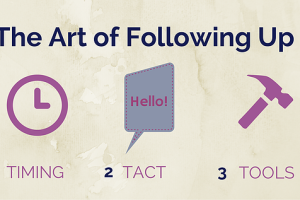This is the second of a series of posts on the importance of bringing a focused methodology to the madness that is the sales environment. In the last post, I outlined my strategy, which focuses on enhancing team selling, shortening sales cycles and closing (more) mutually beneficial deals, summarized by the acronym F.A.S.T.E.R.
Today, we’ll be looking at the first part of that acronym, the letter “F.” – Find the need. This discussion is all about finding a prospect’s genuinely felt needs so that we can accurately target our sales approaches, focusing our efforts on providing solutions rather than gimmicks.
Here are three things we need to do as we set out to “find the need”:
Study the customer
“If you visit the doctor with an ailment, does the doctor immediately prescribe some medicine?” asks management consultant John Flynn. “No, it is more likely that the doctor will first try to understand more about your symptoms, your history, your recent activities, etc., and only after a period of consultation and dialogue will the topic of medicine or any other form of corrective action arise.”
This is a very appropriate analogy for us to consider as we begin looking for customer needs that our product could effectively address. Too often, we act like a doctor who indiscriminately prescribes the same drug for every patient. We assume that we already know what our customers need, and so we go into sales presentations enthusiastically describing feature after feature, fully convinced that our products will make life so much easier for our prospects. But then we’re bewildered when deals fail to materialize, and we’re left wondering what went wrong.
It’s simple, really. Because we didn’t take the time to study our individual customers thoroughly beforehand, we didn’t have an accurate picture of our customers’ real needs. Because we didn’t spend enough time getting to know how our customers do business, we didn’t have a good handle on exactly which sorts of problems they are actually facing on a day-to-day basis. In short, we didn’t do our homework.
Even if we have a good handle on the basic expectations of our product market (and we better at least have that much going for us before we try selling anything), it would be foolhardy for us to assume that the individual needs of every potential customer within that market will look the same. There are a tremendous number of variables—most of them unseen—that affect the desirability of what we have to offer for a company’s bottom line. What seems affordable to one company might be financially inconceivable to another. A feature that helps streamline business operations for one company might, in fact, create additional work for employees in another.
It’s our job to study a prospect’s business challenges up-front, both to ensure that our products will be a good fit and to create a foundation upon which a strong sales rapport can be built when it comes time to pitch a solution.
Some of this will entail creative fact-finding in advance of the first sales meeting. Company websites and blogs, press releases and news stories, and publicly available documents like financial statements and strategic plans can all provide a wealth of insight into a prospect’s long-term goals and current challenges.
A company’s website is also a great place to learn about the kinds of values that matter most to the organization, and to begin ascertaining who the key influencers and decision-makers are likely to be.
By far the greatest amount of information we’re going to obtain about our customers, however, will come from thoughtful, probing questions that will help us better understand our customers’ needs.
This means that we will probably spend our first sales meetings letting the customer do much of the talking. It’s not that we should expect the customer to just supply us with “sales ammo” so that we can fire it right back at them, of course. We need to demonstrate confidence and competence as we study our customer’s needs.
Nevertheless, too many deals are ineptly pitched by what veteran entrepreneur Mark Suster memorably terms “crocodile salespeople.” Such individuals, he says, have tiny ears and huge mouths: they spend far too much time talking about what they have to sell and far too little time listening to what their potential customers may have to say. This is very unwise sales practice, particularly in the early stages of a deal, when the full scope of a customer’s needs may not be apparent.
Smart salespeople also know how to listen actively. They take brief notes as their prospects describe key business processes and productivity hurdles. They ask gently-worded, open-ended questions that prompt the customer to reveal key details. They strive to keep the customer talking until certain data emerge organically in the conversation. As HubSpot Academy lead Mark Kilens explains, “The goal of asking questions is to slowly discover what the lead’s goals are, the plan they might have to reach those goals, the challenges that are in the way of executing this plan, and the timeline that’s in place for reaching them.”
Identify the pain points
Business experts Jon Burgstone and Bill Murphy, Jr., observe that people really only spend money for two reasons: to combat pain and to pursue pleasure. “We list pain and pleasure in that order for a reason,” they explain. “All things being equal, the more acute the pain or problem, the more likely it is that you’ll be able to offer a compelling solution. The more compelling the solution, the more quickly the customer will pay.”
Over the course of our investigations into a prospects’ business hurdles, we should be alert to recognize those places where customers are experiencing their most costly challenges, because these will be the problems that they are most interested in solving.
In my experiences, all such pain points condense into three categories. From the customer’s vantage… a viable solution must satisfy at least one (and preferably more than one) of the following:
-
increasing revenues
-
reducing expenses
-
generating productivity efficiencies
Generally speaking, customers are well aware of unprofitable circumstances affecting their bottom lines, and so when a salesperson both demonstrates familiarity with those circumstances and claims to have a solution, they want to pay attention.
They may be skeptical of the salesperson’s motives, of course, which is precisely why the salesperson must have sufficient data and competence to demonstrate value in the sales proposition. It is incumbent on us to exhibit in concrete terms how our product can increase the overall profitability of a company’s operations, whether by bringing in more money or by reducing the money going out (or both).
Nearly all customer pain points trickle down to the bottom line, so we should always be on the lookout for ways to quantify and monetize the gains we expect our customers to realize as a result of implementing our solutions. If we find we cannot do this very easily, it may be a clue that we’re not positioned to address a genuine pain point in the first place, and that will be a tough sell.
There’s a secondary perk for salespeople who uncover customer pain points: no guilt!
There is absolutely no need for us to feel manipulative or dishonest about proposing a solution to a problem, even when we stand to benefit from the sale—so long as it’s truly a viable solution and not merely a gimmick.
On this topic, Laura Hancock, co-owner of ContentEqualsMoney.com, makes a very good point: “When you hit a pain point, you aren’t taking advantage of a client/customer. Instead, you draw their attention to something that needs to be corrected. And, you offer the ideal method.”
That’s something we can walk away from a deal feeling good about.
Solution-based sales is truly a win-win proposition.
Be prepared to educate
Sometimes (perhaps more often than we would imagine), our investigations into customer business processes and outputs will yield insights into problems that have gone undetected or under-addressed by the customer in the past.
Let’s get something straight though – customers are people.
They appreciate the world through the prism of their experiences. They sense what challenges or bothers them—their pain—but they often can’t even conceive of the solutions—their needs.
Perhaps a customer has overlooked an inefficiency in a manufacturing process, for instance, or perhaps a prospect simply needs to see the math to realize how much a successful product implementation could save them in input costs. Whatever the case, part of the salesperson’s job is to politely but generously educate a potential customer about opportunities for improvement.
This is true whether the sale ultimately works out or not. When we position ourselves as consultative resources, we make big strides toward earning a customer’s trust and brand loyalty, and that can issue in valuable referrals even when our solutions turn out to be a poor fit for a particular client. So it definitely pays for us to be the one who knows our customers’ problems inside and out, because that positions us to be the ideal supplier, not only of knowledge, but also of the best solution.
Once we’ve taken these steps to “Find the need,” and especially once we’re confident that our product is uniquely suited to address a customer’s pain points, then it’s time for us to “articulate the solution” and get the customer on-board. We’ll talk more about that next time.








